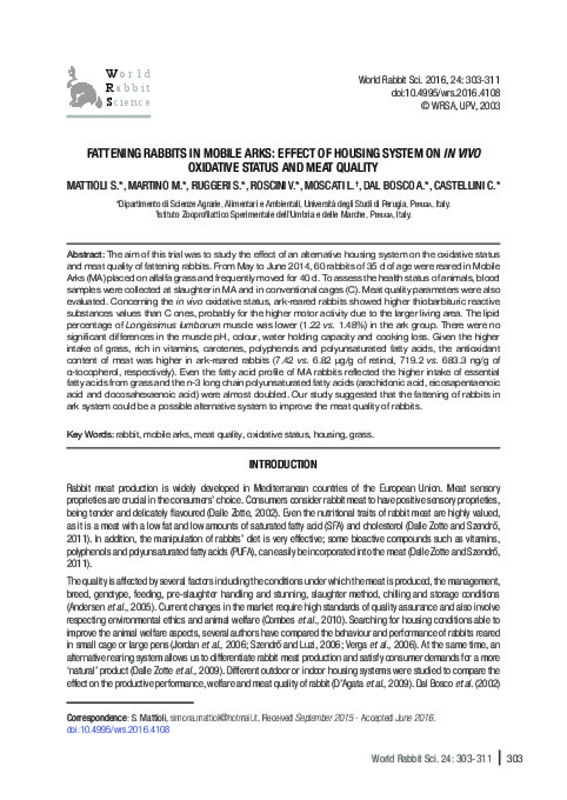JavaScript is disabled for your browser. Some features of this site may not work without it.
Buscar en RiuNet
Listar
Mi cuenta
Estadísticas
Ayuda RiuNet
Admin. UPV
Fattening rabbits in mobile arks: effect of housing system on in vivo oxidative status and meat quality
Mostrar el registro sencillo del ítem
Ficheros en el ítem
| dc.contributor.author | Mattioli, S.
|
es_ES |
| dc.contributor.author | Martino, M.
|
es_ES |
| dc.contributor.author | Ruggeri, S.
|
es_ES |
| dc.contributor.author | Roscini, V.
|
es_ES |
| dc.contributor.author | Moscati, L.
|
es_ES |
| dc.contributor.author | Dal Bosco, A.
|
es_ES |
| dc.contributor.author | Castellini, C.
|
es_ES |
| dc.date.accessioned | 2017-03-28T11:35:04Z | |
| dc.date.available | 2017-03-28T11:35:04Z | |
| dc.date.issued | 2016-12-28 | |
| dc.identifier.issn | 1257-5011 | |
| dc.identifier.uri | http://hdl.handle.net/10251/79157 | |
| dc.description.abstract | [EN] The aim of this trial was to study the effect of an alternative housing system on the oxidative status and meat quality of fattening rabbits. From May to June 2014, 60 rabbits of 35 d of age were reared in Mobile Arks (MA) placed on alfalfa grass and frequently moved for 40 d. To assess the health status of animals, blood samples were collected at slaughter in MA and in conventional cages (C). Meat quality parameters were also evaluated. Concerning the in vivo oxidative status, ark-reared rabbits showed higher thiobarbituric reactive substances values than C ones, probably for the higher motor activity due to the larger living area. The lipid percentage of Longissimus lumborum muscle was lower (1.22 vs. 1.48%) in the ark group. There were no significant differences in the muscle pH, colour, water holding capacity and cooking loss. Given the higher intake of grass, rich in vitamins, carotenes, polyphenols and polyunsaturated fatty acids, the antioxidant content of meat was higher in ark-reared rabbits (7.42 vs. 6.82 µg/g of retinol, 719.2 vs. 683.3 ng/g of α-tocopherol, respectively). Even the fatty acid profile of MA rabbits reflected the higher intake of essential fatty acids from grass and the n-3 long chain polyunsaturated fatty acids (arachidonic acid, eicosapentaenoic acid and docosahexaenoic acid) were almost doubled. Our study suggested that the fattening of rabbits in ark system could be a possible alternative system to improve the meat quality of rabbits. | es_ES |
| dc.description.sponsorship | Research supported by the ANIHWA European Project. The authors wish to thank Massimiliano Crosta of Az. Agricola Brachino Patrizia (Bagnoregio, VT, Italy) and Dott. Beniamino Setta for technical assistance. | |
| dc.language | Inglés | es_ES |
| dc.publisher | Universitat Politècnica de València | |
| dc.relation.ispartof | World Rabbit Science | |
| dc.rights | Reserva de todos los derechos | es_ES |
| dc.subject | Rabbit | es_ES |
| dc.subject | Mobile arks | es_ES |
| dc.subject | Meat quality | es_ES |
| dc.subject | Oxidative status | es_ES |
| dc.subject | Housing | es_ES |
| dc.subject | Grass | es_ES |
| dc.title | Fattening rabbits in mobile arks: effect of housing system on in vivo oxidative status and meat quality | es_ES |
| dc.type | Artículo | es_ES |
| dc.date.updated | 2017-03-28T10:01:36Z | |
| dc.identifier.doi | 10.4995/wrs.2016.4108 | |
| dc.relation.projectID | info:eu-repo/grantAgreement/EC/FP7/291815/EU/Animal Health and Welfare/ | |
| dc.rights.accessRights | Abierto | es_ES |
| dc.description.bibliographicCitation | Mattioli, S.; Martino, M.; Ruggeri, S.; Roscini, V.; Moscati, L.; Dal Bosco, A.; Castellini, C. (2016). Fattening rabbits in mobile arks: effect of housing system on in vivo oxidative status and meat quality. World Rabbit Science. 24(4):303-311. https://doi.org/10.4995/wrs.2016.4108 | es_ES |
| dc.description.accrualMethod | SWORD | es_ES |
| dc.relation.publisherversion | https://doi.org/10.4995/wrs.2016.4108 | es_ES |
| dc.description.upvformatpinicio | 303 | es_ES |
| dc.description.upvformatpfin | 311 | es_ES |
| dc.type.version | info:eu-repo/semantics/publishedVersion | es_ES |
| dc.description.volume | 24 | |
| dc.description.issue | 4 | |
| dc.identifier.eissn | 1989-8886 | |
| dc.contributor.funder | European Commission |








